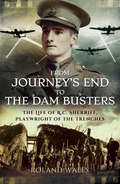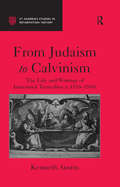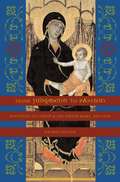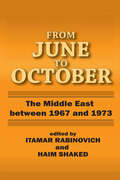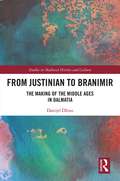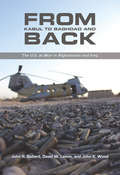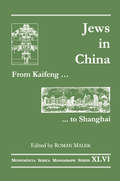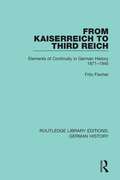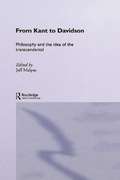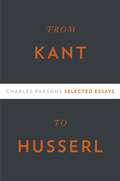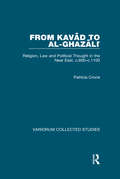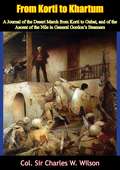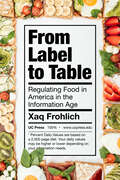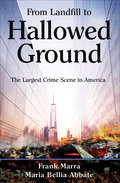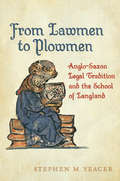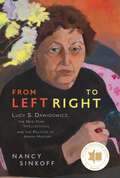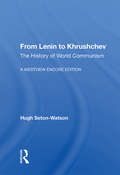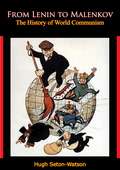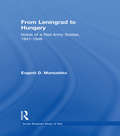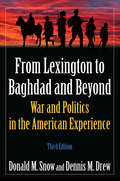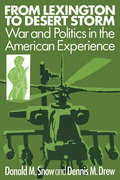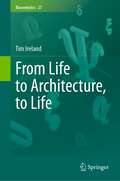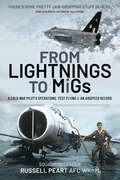- Table View
- List View
From Journey's End to The Dam Busters: The Life of R.C. Sherriff, Playwright of the Trenches
by Roland WalesKingston playwright R.C. Sherriff came to fame with his First World War drama Journeys End, which was based on his own experiences as a young officer on the Western Front. Its success made him a household name and opened the door to a highly lucrative career as a novelist, playwright and screenwriter in Hollywood and in Britain. Many of his movies The Invisible Man, Goodbye Mr Chips, The Four Feathers Odd Man Out, Quartet, and, of course, The Dam Busters are still well known, but the man behind them much less so. This book rediscovers Sherriff using his own words his letters, diaries, published and unpublished manuscripts to shed light on a man who ironically gained his greatest success from the trench warfare he found so difficult to bear.
From Judaism to Calvinism: The Life and Writings of Immanuel Tremellius (c.1510-1580) (St Andrews Studies in Reformation History)
by Kenneth AustinImmanuel Tremellius (c.1510-1580) was one of the most distinguished scholars of the Reformation era. Following his conversion to Christianity from Judaism, he rose to prominence in the mid-sixteenth century as a professor of Hebrew and Old Testament studies, teaching in numerous highly prestigious Reformed academies and universities across northern Europe. Through his activities in the classroom, and his connections with many of the leading religious and political figures of the age, he had a significant impact on the world around him; but through his published writings, some of which were printed through until the eighteenth century, his influence extended long beyond his death. This study of Tremellius' life and works, his first biography since the nineteenth-century, and the first ever full-length study, uses a chronological framework to trace his spiritual journey from Judaism through Catholicism and on to Calvinism, as well as his physical journey across Europe. Into this structure is woven a broader thematic analysis of Tremellius' place within the history of the Reformation, both as a Christian scholar and teacher, and as a converted Jew. The book includes a detailed examination of Tremellius' two most important publications, his Latin translations of the New Testament from Syriac, of 1569, and of the Old Testament from Hebrew, of 1575-1579. By looking at their composition, the figures to whom they were dedicated, their appearance, textual annotations, choice of language and publishing history, much is revealed about biblical scholarship in the sixteenth century as a whole, and about the roles which these works, in particular, would have filled. It is on these works, above all, that Tremellius' long-term international reputation rests. Encompassing issues of theology, education and religious identity, this book not only provides a fascinating biography of one of the most neglected biblical scholars of the sixteenth century, but also sheds much light on th
From Judgment to Passion: Devotion to Christ and the Virgin Mary, 800-1200
by Rachel FultonHow and why did the images of the crucified Christ and his grieving mother achieve such prominence, inspiring unparalleled religious creativity as well such imitative extremes as celibacy and self-flagellation? To answer this question, Fulton ranges over developments in liturgical performance, private prayer, doctrine, and art.
From Judgment to Passion: Devotion to Christ and the Virgin Mary, 800–1200
by Rachel Fulton BrownDevotion to the crucified Christ is one of the most familiar, yet most disconcerting artifacts of medieval European civilization. How and why did the images of the dying God-man and his grieving mother achieve such prominence, inspiring unparalleled religious creativity as well such imitative extremes as celibacy and self-flagellation? To answer this question, Rachel Fulton ranges over developments in liturgical performance, private prayer, doctrine, and art. She considers the fear occasioned by the disappointed hopes of medieval Christians convinced that the apocalypse would come soon, the revulsion of medieval Jews at being baptized in the name of God born from a woman, the reform of the Church in light of a new European money economy, the eroticism of the Marian exegesis of the Song of Songs, and much more. Devotion to the crucified Christ is one of the most familiar yet disconcerting artifacts of medieval European civilization. How and why did the images of the dying God-man and his grieving mother achieve such prominence, inspiring unparalleled religious creativity and emotional artistry even as they fostered such imitative extremes as celibacy, crusade, and self-flagellation?Magisterial in style and comprehensive in scope, From Judgment to Passion is the first systematic attempt to explain the origins and initial development of European devotion to Christ in his suffering humanity and Mary in her compassionate grief. Rachel Fulton examines liturgical performance, doctrine, private prayer, scriptural exegesis, and art in order to illuminate and explain the powerful desire shared by medieval women and men to identify with the crucified Christ and his mother.The book begins with the Carolingian campaign to convert the newly conquered pagan Saxons, in particular with the effort to explain for these new converts the mystery of the Eucharist, the miraculous presence of Christ's body at the Mass. Moving on to the early eleventh century, when Christ's failure to return on the millennium of his Passion (A.D. 1033) necessitated for believers a radical revision of Christian history, Fulton examines the novel liturgies and devotions that arose amid this apocalyptic disappointment. The book turns finally to the twelfth century when, in the wake of the capture of Jerusalem in the First Crusade, there occurred the full flowering of a new, more emotional sensibility of faith, epitomized by the eroticism of the Marian exegesis of the Song of Songs and by the artistic and architectural innovations we have come to think of as quintessentially high medieval.In addition to its concern with explaining devotional change, From Judgment to Passion presses a second, crucial question: How is it possible for modern historians to understand not only the social and cultural functions but also the experience of faith—the impulsive engagement with the emotions, sometimes ineffable, of prayer and devotion? The answer, magnificently exemplified throughout this book's narrative, lies in imaginative empathy, the same incorporation of self into story that lay at the heart of the medieval effort to identify with Christ and Mary in their love and pain.
From June to October: Middle East Between 1967 and 1973
by Itamar RabinovichThe causes of the October War in Israel can be traced to the political, economic, and strategic processes that occurred in the Middle East between 1967 and 1973. The papers compiled in this book were presented in the aftermath of the October War at an international colloquium held at Tel Aviv University.The growth 'and power of Middle East oil-producing countries, changes in inter-Arab relations, domestic policies, foreign policies, and strategic changes in the Middle East arena are analyzed and evaluated by American and Israeli scholars. American foreign policy, Soviet military doctrine, and Arab war aims are dealt with as well. The introduction which summarizes the discussion reflects the perspective of December 1974 from which the events of the years 1967-1973 were seen and evaluated.
From Justinian to Branimir: The Making of the Middle Ages in Dalmatia (Studies in Medieval History and Culture)
by Danijel DžinoFrom Justinian to Branimir explores the social and political transformation of Dalmatia between c.500 and c.900 AD. The collapse of Dalmatia in the early seventh century is traditionally ascribed to the Slav migrations. However, more recent scholarship has started to challenge this theory, looking instead for alternative explanations for the cultural and social changes that took place during this period. Drawing on both written and material sources, this study utilizes recent archaeological and historical research to provide a new historical narrative of this little-known period in the history of the Balkan peninsula. This book will appeal to scholars and students interested in Byzantine and early medieval Europe, the Balkans and the Mediterranean. It is important reading for both historians and archaeologists.
From Kabul to Baghdad and Back
by David W. Lamm John R. Ballard John K. WoodFrom Kabul to Baghdad and Back provides insight into the key strategic decisions of the Afghan and Iraq campaigns as the United States attempted to wage both simultaneously against al-Qaeda and its supporting affiliates. It also evaluates the strategic execution of those military campaigns to identify how well the two operations were conducted in light of their political objectives. The book identifies the elements that made the 2001 military operation to oust the Taliban successful, then with combat operations in Iraq as a standard of comparison, the authors analyze the remainder of the Afghan campaign and the essential problems that plagued that effort, from the decision to go to war with Iraq in 2002, through the ill-fated transition to NATO lead in Afghanistan in 2006, the dismissal of Generals McKiernan and McChrystal, the eventual decision by President Obama to make the Afghan campaign the main effort in the war on extremism, and the final development of drawdown plans following the end of the war in Iraq. No other book successfully compares and contrasts the campaigns in Iraq and Afghanistan from a national strategic perspective, analyzing the impact of fighting the Iraq War on the success of the United States campaign in Afghanistan. It is also the first book to specifically question several key operational decisions in Afghanistan including: the decision to give NATO the lead in Afghanistan, the decisions to fire Generals McKiernan and McChrystal and the decision to conduct an Iraq War-style surge in Afghanistan. It also compares the Afghan campaigns fought by the Soviet Union and the United States, the counterinsurgency campaigns styles in Iraq and Afghanistan and the leadership of senior American officials in both Iraq and Afghanistan. In the final chapter, the key lessons of the two campaigns are outlined, including the importance of effective strategic decision-making, the utility of population focused counterinsurgency practices, the challenges of building partner capacity during combat, and the mindset required to prosecute modern war.
From Kaifeng to Shanghai: Jews in China (Monumenta Serica Monograph Ser.)
by Roman MalekThe collection presents the proceedings of the international colloquium held in Sankt Augustin in 1997 and additional materials. The articles are written in English, German or Chinese (with English abstracts). The volume includes a general index with glossary.
From Kaiserreich to Third Reich: Elements of Continuity in German History 1871-1945 (Routledge Library Editions: German History #13)
by Fritz FischerOriginally published in English in 1986, this book offers a concise summary of the contribution Fritz Fischer and his school made to German historiography in the 20th century and in particular draws attention to continuity in the development and power structures of the German Reich between 1871 and 1945. After 1866 the traditional elites wanted to avoid fundamental changes in society, expecting a victorious war to secure their own position at home and to broaden the European base of the German Reich. Even as the Blitzkrieg expectations foundered, these ambitions persisted beyond 1918. In the face of working-class hostility, these elites were unable to mobilize mass support for their interests, but Hitler fashioned a mass party. The alliance between these unequal partners led to the Third Reich but with its collapse in 1945 the Prusso-German Reich came to an end. Only with the German Federal Republic did the liberal-democratic traditions of German history again come into their own.
From Kant to Davidson: Philosophy and the Idea of the Transcendental (Routledge Studies in Twentieth-Century Philosophy)
by Jeff MalpasRecent philosophy has seen the idea of the transcendental, first introduced in its modern form in the work of Kant, take on a new prominence.Bringing together an international range of younger philosophers and established thinkers, this volume opens up the idea of the transcendental, examining it not merely as a mode of argument, but as naming a particular problematic and a philosophical style.With contributions engaging with both analytic and continental approaches, this book will be of essential interest to philosophers and philosophy students interested in the idea of the transcendental and the part that it plays in modern and contemporary philosophy.
From Kant to Husserl
by Charles ParsonsIn From Kant to Husserl, Charles Parsons examines a wide range of historical opinion on philosophical questions, from mathematics to phenomenology. Amplifying his early ideas on Kant’s philosophy of arithmetic, Parsons uses Kant’s lectures on metaphysics to explore how his arithmetical concepts relate to the categories. He then turns to early reactions by two immediate successors of Kant, Johann Schultz and Bernard Bolzano, to shed light on disputed questions regarding interpretation of Kant’s philosophy of mathematics. Interested, as well, in what Kant meant by pure natural science, Parsons considers the relationship between the first Critique and the Metaphysical Foundations of Natural Science. His commentary on Kant’s Transcendental Aesthetic departs from mathematics to engage the vexed question of what it tells about the meaning of Kant’s transcendental idealism. Proceeding on to phenomenology, Parsons examines Frege’s evolving idea of extensions, his attitude toward set theory, and his correspondence, particularly exchanges with Russell and Husserl. An essay on Brentano brings out, in the case of judgment, an alternative to the now standard Fregean view of negation, and, on truth, alternatives to the traditional correspondence view that are still discussed today. Ending with the question of why Husserl did not take the linguistic turn, a final essay included here marks the only article-length discussion of Husserl Parsons has ever written, despite a long-standing engagement with this philosopher.
From Kavad to al-Ghazali: Religion, Law and Political Thought in the Near East, c.600–c.1100 (Variorum Collected Studies)
by Patricia CroneThis volume brings together twelve articles by Patricia Crone dealing with pre-Islamic and Islamic religion, law and political thought. The first section focuses on the centuries before Islam, with studies on Mazdakism in Iran and on Islam as the key factor behind the outbreak of Iconoclasm in Byzantium. The second group of studies looks at problems in legal history, including the codification of the Qur'an, while the third investigates questions of political thought, amongst them a study of early Muslim anarchists, and an examination of the authorship of a work ascribed to al-Ghazali.
From Korti to Khartum: A Journal of the Desert March from Korti to Gubat, and of the Ascent of the Nile in General Gordon’s Steamers [Ill. Ed.]
by Col. Sir Charles W. WilsonFrom 1884 to 1885, British Army officer Charles William Wilson took part in the Khartoum Relief Expedition, commanded by Garnet Wolseley. He was part of the advance rescue force led by Sir Herbert Stewart. After Stewart was mortally wounded Brigadier-General Wilson took command of this group of about 1,400 men. On two Nile steamers Wilson’s Desert Column reached Khartoum in the afternoon of 28 January 1885. It came two days too late: Khartoum had been seized by the Mahdists in the early hours of January 26. Between 5,000 and 10,000 inhabitants were slaughtered, among them Major-General Charles George Gordon.This book, first published in 1886, is Charles William Wilson’s Journal of the march from Korti to Gubat, and of the voyage in General Gordon’s steamers to the junction of the two Niles. The Journal formed part of a daily journal that Wilson kept whilst employed in the Sudan, and sent home by nearly every mail. It was transcribed from his field-notes immediately following his return to Korti, whilst all the events which it describes were still fresh in his memory. Wilson released it to the public upon strong encouragement of his friends back home in England, allowing the reader to read for himself the vivid account “of courage […] of discipline […] of dash […] of endurance […].”Richly illustrated with a special picture and map pack.
From Label to Table: Regulating Food in America in the Information Age (California Studies in Food and Culture #82)
by Xaq FrohlichHow did the Nutrition Facts label come to appear on millions of everyday American household food products? As Xaq Frohlich reveals, this legal, scientific, and seemingly innocuous strip of information can be a prism through which to view the high-stakes political battles and development of scientific ideas that have shaped the realms of American health, nutrition, and public communication. By tracing policy debates at the U.S. Food and Drug Administration, Frohlich describes the emergence of our present information age in food and diet markets and examines how powerful government offices inform the public about what they consume. From Label to Table explores evolving popular ideas about food, diet, and responsibility for health that have influenced what goes on the Nutrition Facts label—and who gets to decide that.
From Landfill to Hallowed Ground: The Largest Crime Scene in America
by Frank Marra Maria Bellia AbbateAn NYPD sergeant shares his experiences in the tragic aftermath of 9/11 and the tireless search for remains among the debris of the Twin Towers.The morning of September 11, 2001, began like any other Tuesday for police Sergeant Frank Marra. He woke up early, brewed his coffee, and got his son Anthony ready for kindergarten. Then a shocking image interrupted televised broadcasts nationwide: the South Tower of the World Trade Center was engulfed in flames and smoke. Sergeant Marra stared in shock at what would become the largest crime scene he would ever investigate.Marra spent months at the Staten Island Landfill, where the 1.6 million tons of debris was searched for any form of evidence that could help identify the victims, including the remains of those buried beneath. Officers and volunteers worked tirelessly, often at great cost to themselves, to bring closure for so many grieving families. This heartrending story gives readers a rare and intimate glimpse into the days and months following the attack on September 11, and the stories that echo from &“The Hill&”—the hallowed ground of those who perished on that fateful day.
From Lawmen to Plowmen
by Stephen YeagerThe reappearance of alliterative verse in the fourteenth and fifteenth centuries remains one of the most puzzling issues in the literary history of medieval England. In From Lawmen to Plowmen, Stephen M. Yeager offers a fresh, insightful explanation for the alliterative structure of William Langland's Piers Plowman and the flourishing of alliterative verse satires in late medieval England by observing the similarities between these satires and the legal-homiletical literature of the Anglo-Saxon era.Unlike Old English alliterative poetry, Anglo-Saxon legal texts and documents continued to be studied long after the Norman Conquest. By comparing Anglo-Saxon charters, sermons, and law codes with Langland's Piers Plowman and similar poems, Yeager demonstrates that this legal and homiletical literature had an influential afterlife in the fourteenth-century poetry of William Langland and his imitators. His conclusions establish a new genealogy for medieval England's vernacular literary tradition and offer a new way of approaching one of Middle English's literary classics.
From Left to Right: Lucy S. Dawidowicz, the New York Intellectuals, and the Politics of Jewish History
by Nancy SinkoffFrom Left to Right: Lucy S. Dawidowicz, the New York Intellectuals, and the Politics of Jewish History is the first comprehensive biography of Dawidowicz (1915–1990), a pioneer historian in the field that is now called Holocaust studies. Dawidowicz was a household name in the postwar years, not only because of her scholarship but also due to her political views. Dawidowicz, like many other New York intellectuals, was a youthful communist, became an FDR democrat midcentury, and later championed neoconservatism. Nancy Sinkoff argues that Dawidowicz’s rightward shift emerged out of living in prewar Poland, watching the Holocaust unfold from New York City, and working with displaced persons in postwar Germany. Based on over forty-five archival collections, From Left to Right chronicles Dawidowicz’s life as a window into the major events and issues of twentieth-century Jewish life. From Left to Right is structured in four parts. Part 1 tells the story of Dawidowicz’s childhood, adolescence, and college years when she was an immigrant daughter living in New York City. Part 2 narrates Dawidowicz’s formative European years in Poland, New York City (when she was enclosed in the European-like world of the New York YIVO), and Germany. Part 3 tells how Dawidowicz became an American while Polish Jewish civilization was still inscribed in her heart and also explores when and how Dawidowicz became the voice of East European Jewry for the American Jewish public. Part 4 exposes the fissure between Dawidowicz’s European-inflected diaspora nationalist modern Jewish identity and the shifting definition of American liberalism from the late 1960s forward, which also saw the emergence of neoconservatism. The book includes an interpretation of her memoir From that Place and Time, as well as an appendix of thirty-one previously unpublished letters that illustrate the broad reach of her work and person. Dawidowicz’s right-wing politics, sex, and unabashed commitment to Jewish particularism in an East European Jewish key have resulted in scholarly neglect. Therefore, this book is strongly recommended for scholars and general readers interested in Jewish and women’s studies.
From Lenin To Khrushchev: The History Of World Communism
by Hugh Seton-WatsonThis book is intended to be both less and more than a survey of communism in the world today or a history of communist movements. It focuses on the relationship of communist movements to social classes and to the internal balance of political power in their respective countries.
From Lenin to Malenkov: The History of World Communism
by Hugh Seton-WatsonThis comparative analysis of various communist movements across the globe from eminent British historian and political scientist, Hugh Seton-Watson, delves deeply into the social and political states of countries where communists attempted to seize—and successfully seized—power. The author of many of the mid-20th century’s standard works on Russian and Eastern European history, Seton-Watson’s 1953 study carefully follows the sequence of communist revolution: from the Marxist-Leninist seizure of power in Russia during WWI and its consolidation under Lenin; the rise and horrors of Stalinism in the late 20s, 30s and 40s; the birth of the Comintern and popular front in the inter-war period; the communist inspired/directed resistance movements of the war years; through to the Stalinisation of Eastern Europe in the wake of WWII; the rise and triumph of Mao in China; communist triumphs in Korea and Southeast Asia; and the role of Marxist-Leninist and Stalinist thought in the nationalist/anti-colonialist movements in Africa, Asia and Latin America in the early-mid-20th century.An unmissable addition to your collection!“Both the subject and the literature of communism are vast. Communism is a theory, which professes to explain philosophy, religion, history, economics and society. Communism is a vocation, whose devotees accept its discipline in every part of their private and professional lives. Communism is a science of conspiracy, a technique of wrecking and subversion. Communism is a revolutionary movement, a political force which operates in a social environment, which recruits its members from various classes of society, and marshals its armies against various political opponents.”—Hugh Seton-Watson, Introduction
From Leningrad to Hungary: Notes of a Red Army Soldier, 1941-1946 (Soviet (russian) Study Of War Ser.)
by Evgenii D. MoniushkoThis new book is a chronological narrative of the experiences of Evgenii Moniushko, who lived through and survived the first year of the siege of Leningrad and who served as a junior officer in the Red Army during the last eighteen months of war and the first year of the Soviet occupation of Czechoslovakia and Hungary. This volume presents&nbs
From Lexington to Baghdad and Beyond: War and Politics in the American Experience
by Donald M Snow Dennis M. DrewDecisions about when, where, and why to commit the United States to the use of force, and how to conduct warfare and ultimately end it, are hotly debated not only contemporaneously but also for decades afterward. We are engaged in such a debate today, quite often without a solid grounding in the country's experience of war, both political and military. This book, by a political scientist and a career military officer and historian, is premised on the view that we cannot afford that kind of innocence. Updated and revised with new chapters on the Afghan and Iraq wars, the book systematically examines twelve U.S. wars from the revolution to the present day. For each conflict the authors review underlying issues and events; political objectives; military objectives and strategy; political considerations; military technology and technique; military conduct, and 'the better state of the peace', that is, the ultimate disposition of the original political goals.
From Lexington to Desert Storm: War and Politics in the American Experience
by Donald M Snow Dennis M. DrewFirst Published in 2015. Routledge is an imprint of Taylor & Francis, an Informa company.
From Life to Architecture, to Life (Biosemiotics #27)
by Tim IrelandThe book establishes a correlation between architectural theory and the biosemiotic project, and suggest how this coupling establishes a framework leading to an architectural-biosemiotic paradigm that puts biosemiotic theory at the heart of cognising the built environment, and offers an approach to understanding and shaping the built environment that supports (and benefits) human, and organismic, spatial intelligence.
From Light to Byte: Toward an Ethics of Digital Cinema
by Markos HadjioannouCinema has been undergoing a profound technological shift: celluloid film is being replaced by digital media in the production, distribution, and reception of moving images. Concerned with the debate surrounding digital cinema&’s ontology and the interrelationship between cinema cultures, From Light to Byte investigates the very idea of change as it is expressed in the current technological transition. Markos Hadjioannou asks what is different in the way digital movies depict the world and engage with the individual and how we might best address the issue of technological shift within media archaeologies.Hadjioannou turns to the technical basis of the image as his first point of departure, considering the creative and perceptual activities of moviemakers and viewers. Grounded in film history, film theory, and philosophy, he explores how the digital configures its engagement with reality and the individual while simultaneously replaying and destabilizing celluloid&’s own structures. He observes that, where film&’s photographic foundation encourages an existential association between individual and reality, digital representations are graphic renditions of mathematical codes whose causal relations are more difficult to trace.Throughout this work Hadjioannou examines how the two technologies set themselves up with reference to reality, physicality, spatiality, and temporality, and he concludes that the question concerning digital cinema is ultimately one of ethical implications—a question, that is, of the individual&’s ability to respond to the image of the world.
From Lightnings to MiGs: A Cold War Pilot's Operations, Test Flying & an Airspeed Record
by Russ PeartIt was supposed to be just a training flight. The two Soviet-manufactured MiG 21s, each with two practice bombs and four air-to-ground rockets, were lined up on the runway in Bangladesh at the height of the Cold War, when air traffic control suddenly reported an incursion by Indian Air Force Jaguars. Though ill-equipped for combat, the two MiGs were scrambled. One of the MiGs’ pilots was an RAF officer – Squadron Leader Russell Peart. On a seven-month loan to the Bangladeshi Air Force, Peart suddenly found himself at the centre of the simmering hostility between two neighbouring nations. By the time they reached the area that had been threatened by the Indian pilots, the Jaguars had gone. Later, when Squadron Leader Russell Peart spoke of the incident to the British High Commissioner, he was told not to shoot down any Jaguars as the Indians had still not paid for them! Russell Peart flew many other aircraft in his varied career, including the MiG 19, and while a test pilot at Boscombe Down trialled such designs as the Tornado GR1. But it was whilst he was seconded to the Sultan of Oman’s Air Force, particularly during the so-called ‘Secret War’ in Dhofar, that he saw the most action. In that theatre the author flew some 200 operational sorties, 180 of which involved live fire, during which he was hit many times. He was also hit and wounded by a 75mm shell. Russ Peart has written in detail of his exciting RAF career, from flying Lightnings in the Far East to winning the top prize in the International Tactical Bombing Competition against a handpicked team of United States Air Force fighter pilots and being awarded the Sultan Of Oman’s Distinguished Service Medal. Supplemented by a selection of previously unseen photographs, this uniquely original memoir throws new light on the operational flying undertaken by some RAF pilots during the tense years of the Cold War.
